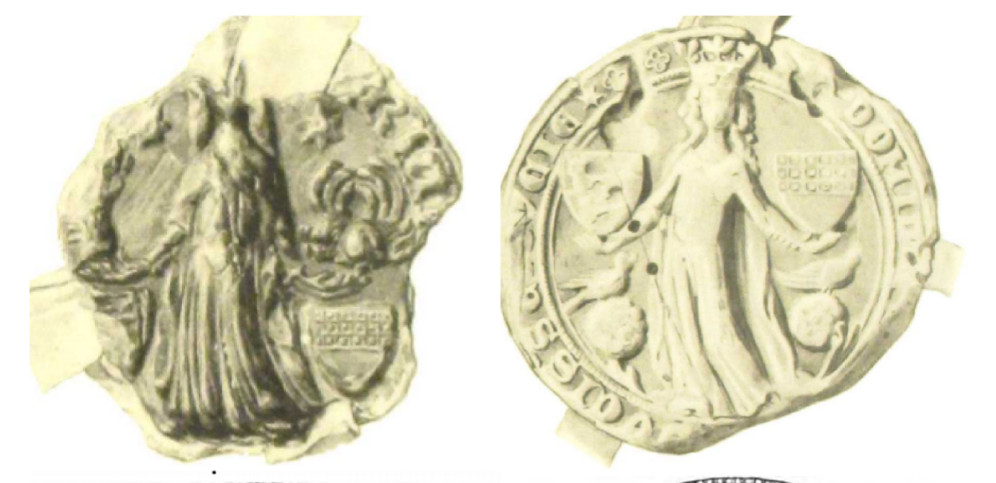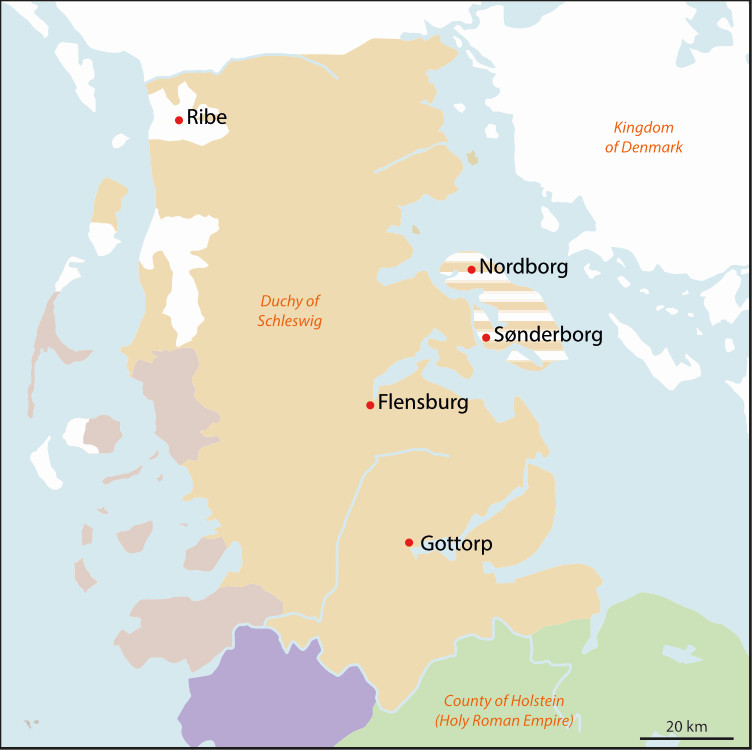Dr Stefan Magnussen of the University of Leipzig looks at the extraodinary case of Duchess Richardis of Schleswig who in the C14 protected her rights over a castle at the expense of her husband’s.
In south-western Denmark, not far from the mouth of the Flensburg Fjord, rises a red-brick castle called Sønderborg (Eng: Southern Castle). Although it is hardly known beyond Denmark, at least its name still radiates throughout Europe as the eponym of the dynasty that originated from it. We do not know today who built the castle, which was first mentioned in 1253, but the eventful history as a residence, in which many men have left an architectural imprint, is well documented.

Yet there were also some women who left their marks – this is especally true for Queen Dowager Dorothea of Saxe-Lauenburg, who commissioned the magnificent palace chapel. One key figure, however, has more or less fallen into oblivion: Duchess Richardis of Schleswig, who played a brief, but prominent role during a royal siege of 1358. Not so much as a leader of defence, but rather as a ruler who self-confidently defended her own interests – even if it meant turning against her spouse.

Overall, very little is known about this woman. She was born around 1320 as the daughter of the Counts of Schwerin-Wittenburg and probably married Duke Valdemar V of Schleswig around 1338, presumably in the course of alliance negotiations. As was customary in those years, she was probably assigned the ducal secondary residence of Sønderborg with the island of Alsen as life tenancy, which made her Lady of Sønderborg for almost half a century until her death around 1386. Nevertheless, apart from the fact that her chaplain came from her native Wittenburg, little is known about her regency. Even her burial place remains a secret.

And yet what makes this enigmatic princess interesting is her key role in her husband‘s conflict with King Valdemar IV of Denmark. Understanding this and her stuation, it is worth telling the story from the beginning: In 1340, King Valdemar IV inherited a difficult legacy, as his realm was almost entirely pledged to various neighbours. Before homage was paid, a series of treaties reorganised these pledges, transferring almost all of Jutland to Duke Valdemar V, who in turn mortgaged his territories to the Counts of Holstein, who were among the leading negotiators. Within a few years, the Danish king succeeded in almost completely redeeming his realm, with the exception of some districts like Ribe Castle on the North Sea, which was still in ducal possession. At the same time, the Duke also succeeded in redeeming two thirds of his duchy from the Counts, who, however, remained holding the ducal principal residence at Gottorp. Since the secondary residence of Sønderborg had also been ceded to the Duchess, the castle district of Ribe constituted the last ducal power base. Notwithstanding this, King Valdemar IV. pressed for this pledge to be dissolved in 1351, which severely curtailed the Duke‘s power. In turn, the duke allied himself with the loyal Jutish nobility and the Counts of Holstein against the Danish king. An early conflict was settled in 1353, but flared up again in 1358.

King Valdemar IV now ventured an advance on the island of Alsen, which lay just off the coast of the duchy in the direction of the kingdom. Within three days he was able to bring Nordborg Castle (Eng: North Castle) under his control, making the conquest of Sønderborg only a matter of time. But it was not the Duke awaiting him there, but Duchess Richardis. The main source for the recreation of the processes now taking place is the contemporary and royalist Younger Zealand Chronicle, which, albeit otherwise only reporting sieges in short, recounts the meeting in surprisingly colourful words. Richardis, together with „her girls“, which probably referred to her dames, had approached the King outside her castle. As she was a fine, clever and, morever, eloquent person, the Danish king immediately recognised her noble personality and decided that his friendship with her brother was more dear to him than enmity with the Duke. Both sides thus agreed that Richardis would be allowed to keep her estate undiminished in return for her promise that no harm would derive from it. That these events actually occurred is witnesses by a preserved charter, which also informs us of another juicy detail: Richardis also banned her husband from staying in his castle. It was only on two days a year that he was allowed to stay there.

So, how can we explain these events and, above all, this dazzling account? Apparently, in the face of the siege, Richardis proved to be a princess with a sense of rank who knew how to protect her sphere of power. With Duke Valdemar V having only a small remaining territory and little income since the loss of his most important castle of Ribe, Richardis had little to rely on from her politically incapacitated husband. Yet, Richardis probably anticipated the royal dilemma, for her brother was one of the king‘s key allies. The duchess and the Danish king thus agreed on a mutually beneficial solution that would potentially establish a royal bridgehead at the doorstep of the Duchy. This agreement, however, had a crucial pitfall in that the castle de iure belonged to the Duke, which legally limited the authority of the Duchess to freely dispose of it. But both sides sought to actively influence the interpretative authority of this conflict between norm and practice via the contract as well as the chronicle. This is indicated by the comparatively extensive set of 21 seals, which may have been intended to symbolise broad support by local elites, but also by the very favourable account of Richardis, which was probably intended to strengthen her personal authority and thus bestow legitimacy on the agreement. Both seem to have succeeded in this endeavour, for in the winter of 1372/73 Valdemar IV was able to use Sønderborg castle as his bridgehead during his advance on the city of Flensburg, and Duke Valdemar V is never again witnessed on Sønderborg Castle until his death in 1364.
Even though Richardis has been forgotten down the years, her brief, but crucial role during the siege of Sønderborg is a vivid testimony to the often concealed power of princesses, who, instead of being a sidekick to their spouses, started themselves to kick if necessary.